Technologies
Samsung Galaxy A14 5G Review: $200 Phone Hits Every Essential
This phone’s best feature should be on every phone.
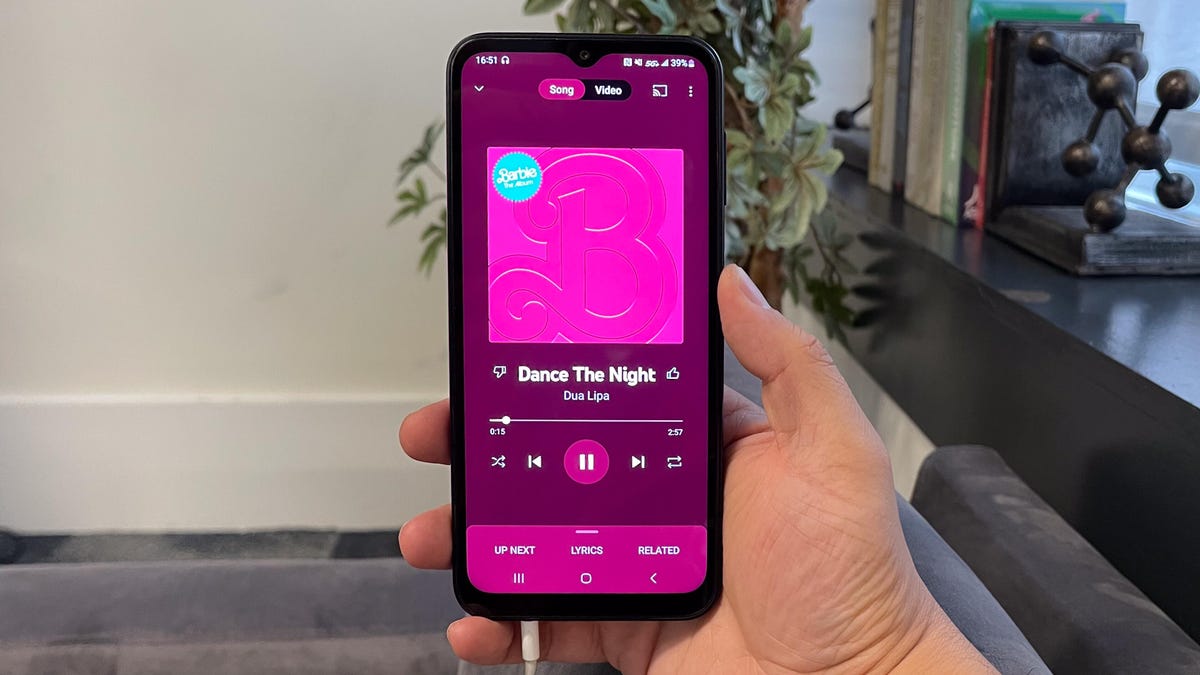
The $200 Samsung Galaxy A14 5G sets a new baseline for cheap phones. It’s one of the few affordable phones to include NFC for contactless payments and support 5G. Even more notable is that Samsung provides two years of software updates along with five years of security updates for the A14, when most similarly priced rivals stop at one software update and three years of security updates. This means that even though the phone’s a lower-cost option, it’s one you could safely use for several years if you chose to — and with perks usually found only in pricier phones, the Galaxy A14 5G is a great choice.
Over my month of testing the Galaxy A14 5G, these inclusions meant I could use the phone to buy a quick breakfast, browse the web while listening to music during my commute, reliably use the phone’s camera for day trips, and with its 5,000-mAh battery, still have enough of a charge left to use the phone the next day.
That’s not to say the phone is issue-free: The Galaxy A14 cuts corners with a fairly drab design and a slower processor that sometimes left me waiting for apps to load. But load they did, and if you’re just looking for a phone that can handle most daily tasks, the A14 could be a solid option as long as you aren’t craving speed.
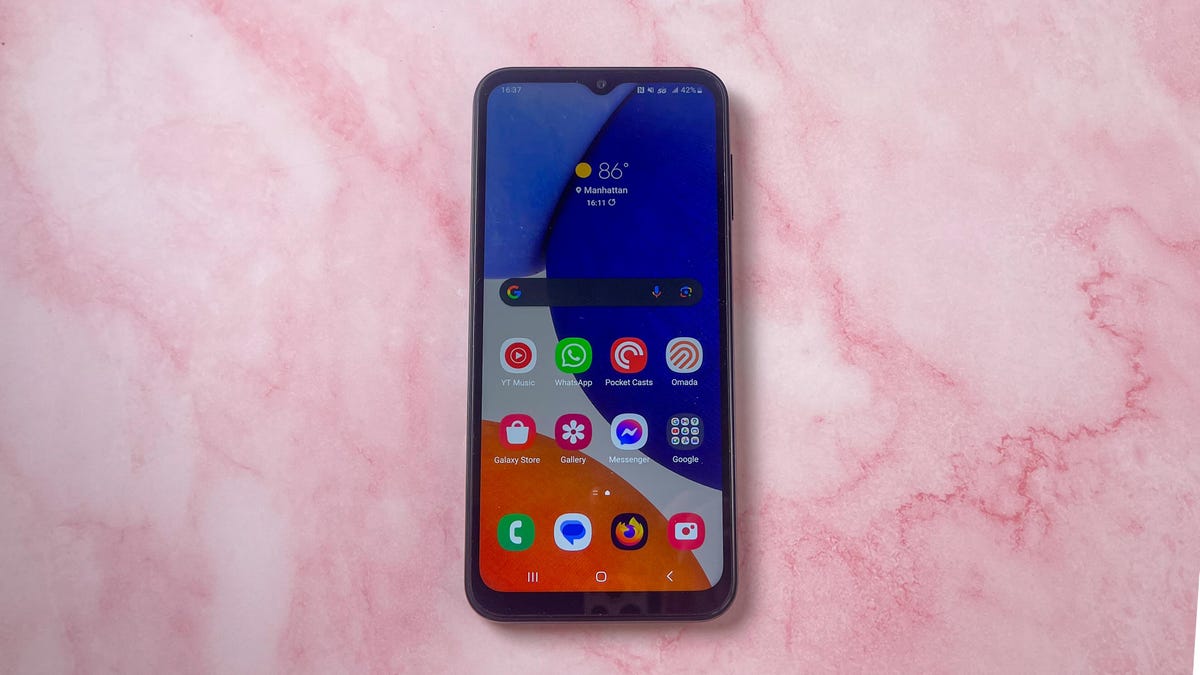
Samsung Galaxy A14 5G design, specs and features
The Galaxy A14 5G comes in one color, black, and has a reflective plastic body. It feels a bit thick in-hand, with the back embracing a blocky look that lacks any rounded edges. Along the top-left corner are its three cameras: a 50-megapixel main camera, a 2-megapixel depth camera and a 2-megapixel macro camera.
Around the front is a teardrop notch for the 13-megapixel front-facing camera. In addition to its 1,080p resolution, the 6.6-inch display has a 90Hz refresh rate. While the $200 Moto G Stylus runs at a consistent 90Hz, the A14 has an «adaptive» mode that adjusts up to 90Hz when scrolling through text and animations while swiping between apps. I found the effect noticeably smooth, especially when I was reading articles or playing games.
The phone plays audio through its single speaker, which was fairly easy for me to accidentally block when I held the phone horizontally to watch videos. It’s notable since Motorola’s current budget phone lineup includes stereo speakers across its Moto G phones, (though the Galaxy A14 does include a headphone jack as an option for stereo audio). While the Samsung phone’s internal 64GB of storage should be enough to get you started, you do get the option of expanding storage to 1TB using the phone’s microSD card slot.

In benchmark testing, the Galaxy A14 5G’s Geekbench score came out ahead of the Moto G Stylus, but it certainly doesn’t feel like it in my real-world use. The phone’s Mediatek Dimensity 700 processor is sluggish, and I often noticed the A14 needing an extra beat to unlock itself when I had another app open, when I tapped a text box to launch the keyboard and when moving between apps. Software updates can refine this in time, and its current performance is totally fine for casual use. But this wouldn’t be a phone that could handle lots of productivity documents or more graphically demanding apps.
Geekbench 6 Benchmarks
- Single-core
- Multi-core
However the Galaxy A14’s inclusion of NFC is quite meaningful, providing full compatibility with Google Wallet for contactless payments. I rarely find NFC for contactless payments in phones under $300, even though it’s accepted everywhere from transit systems to convenience stores. I hope this creates a trend and we’ll finally start seeing NFC become a feature on every phone regardless of cost.
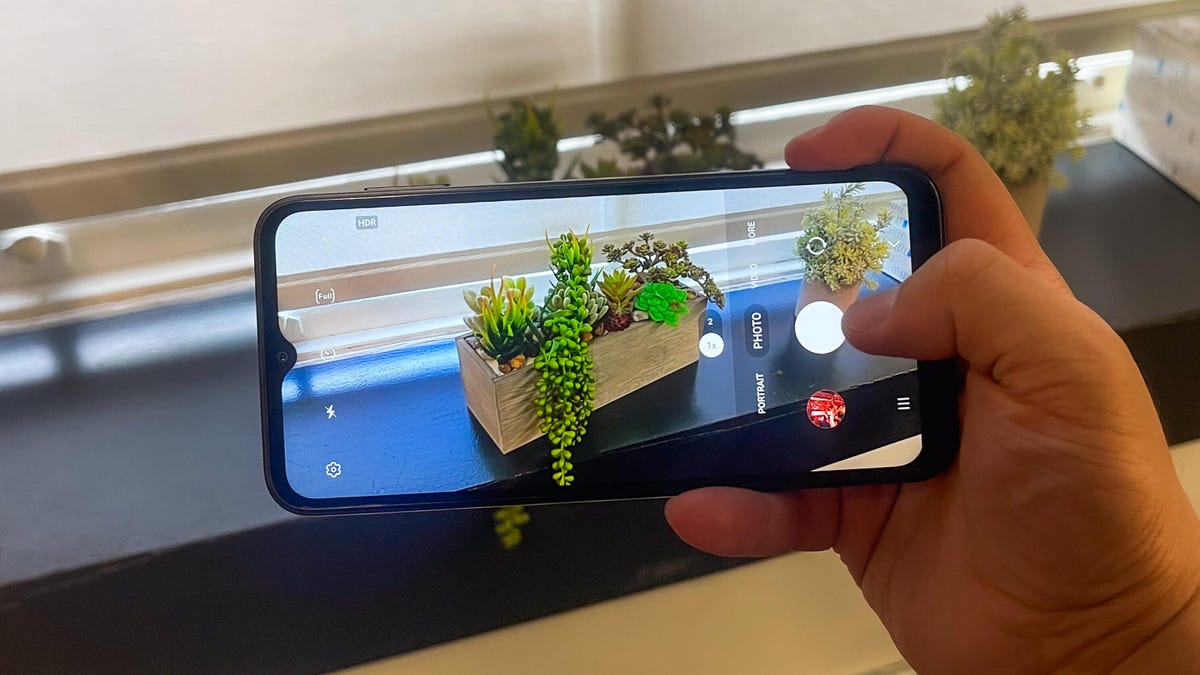
Samsung Galaxy A14 5G cameras and photography
The Galaxy A14’s cameras, despite the inclusion of a 50-megapixel main camera, are a mixed bag. I took the phone on several day trips, including a visit to a Brooklyn anime food festival and during a weekend stop-in to San Diego Comic-Con.
Outdoor photos came out decent as long as there was very little movement. During the anime food festival, my dessert photos of a cheesecake and rabbit milk pudding looked nice, but there was blurriness in most of my other photos whether due to the crowds or movement by the performers during a Taiko drum show.



A selfie I took while outside is decent, but similar to some of Samsung’s more expensive phones, I felt like colors were exaggerated.

This exaggeration also holds true for my test photo of the grass wall in CNET’s office. Photos taken with the Moto G Stylus and the $250 Moto G 5G captured more accurate shades of green than those taken with the Galaxy A14 5G.



And much like other phones in this price range, photo quality proves challenging when moving indoors. Even on the well-lit San Diego Comic-Con floor, my photo taken with Final Fantasy 16’s Ifrit looks fuzzy.

When I moved to Amazon’s Good Omens party, the dim lighting made it a challenge for the A14 to find focus.

Returning to New York, there’s plenty of image noise in this selfie, which I took in the underground La Caverna restaurant, but my photo of the restaurant itself looks better since there weren’t many other people moving around.


Overall the Samsung Galaxy A14’s photography is definitely not punching above its price range. If finding a $200 phone with decent cameras is important to you, Motorola’s latest G-series phones could be a better option. While the Moto G phones have similar issues in darker environments, from my testing I feel like the photos taken by those cameras are slightly better.
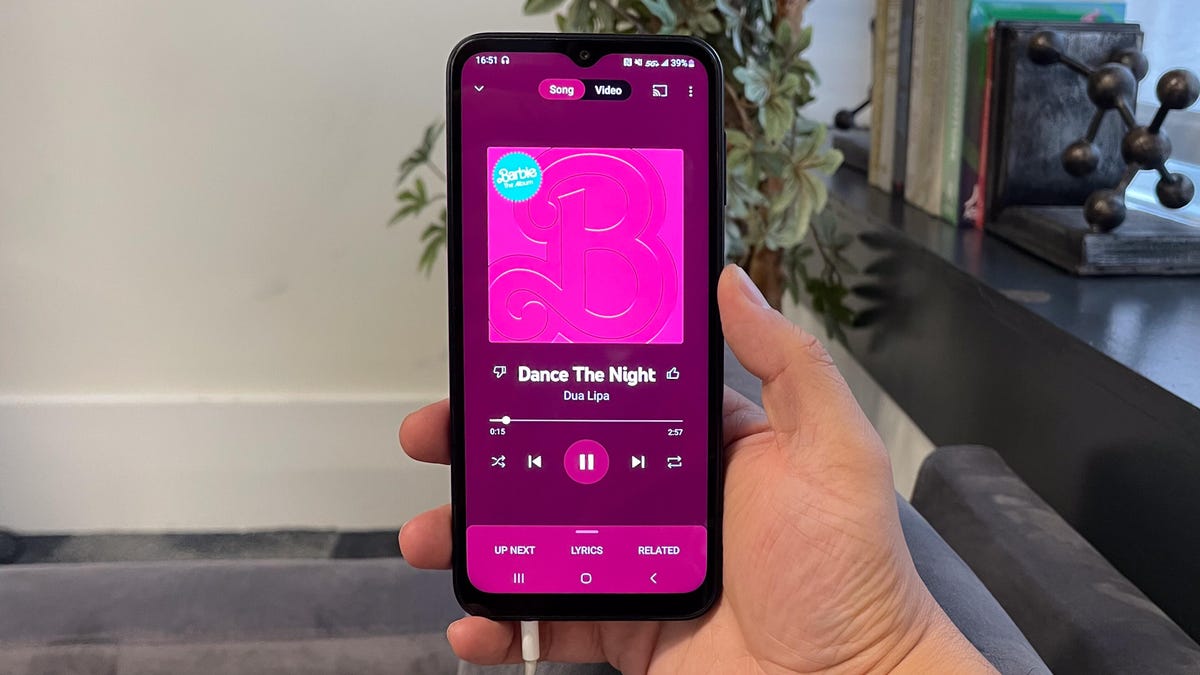
Samsung Galaxy A14 5G Bottom line
The Samsung Galaxy A14 5G is one of the most functional phones I’ve tested for under $200. Even though the phone has noticeable issues — including the slower processor and mixed photography performance — the device is capable of performing most essential tasks. The inclusion of NFC is a clear highlight, and hopefully it means that contactless payment features will now make their way into phones at all prices. The longer security update timeline also means the phone will be safe to use for several years, which could be especially helpful for someone just looking for an affordable device to stay in contact with friends and family.
This makes the Galaxy A14 5G particularly easy to recommend for most people shopping for a phone on a budget, or if the phone is offered for free. But keep in mind that the phone won’t be getting any faster, and should deals or incentives drop the price of a better-equipped phone that normally costs $300, don’t pass that up.
Samsung Galaxy A14 5G vs. Moto G Stylus (2023) vs. Moto G 5G (2023)
| Samsung Galaxy A14 5G | Moto G Stylus (2023) | Moto G 5G (2023) | |
|---|---|---|---|
| Display size, resolution | 6.6-inch FHD+ LCD display, (1,400×1,080 pixels), 90Hz | 6.5-inch IPS LCD; 1,600×720; 90Hz refresh rate | 6.5-inch HD Plus LCD display (720p resolution); 120Hz refresh rate |
| Pixel density | 268 ppi | 269 ppi | 269 ppi |
| Dimensions (inches) | 6.6×3.07×0.36 in | 6.41×2.91×0.36 in | 6.45×2.95×0.33 in. |
| Dimensions (millimeters) | 167.6×77.9×9.1 mm | 162.9×74.1×9.2 mm | 163.94×74.98×8.39mm |
| Weight (ounces, grams) | 203 g (7.19 oz) | 195 g | 189g (6.66 oz.) |
| Mobile software | Android 13 | Android 13 | Android 13 |
| Camera | 50-megapixel (main), 2-megapixel (macro), 2-megapixel (depth) | 50-megapixel (main), 2-megapixel (macro) | 48-megapixel main, 2-megapixel macro |
| Front-facing camera | 13-megapixel | 8-megapixel | 8-megapixel |
| Video capture | 1080p at 30 fps | 1080p at 30 fps | 720p at 30fps |
| Processor | MediaTek Dimensity 700 | MediaTek Helio G85 | Snapdragon 480 Plus |
| RAM/Storage | 4GB + 64GB | 4GB + 64GB; 4GB + 128GB | 4GB + 128GB |
| Expandable storage | Yes | Yes | Yes |
| Battery/Charger | 5,000 mAh (15W charging) | 5,000 mAh (15W charging) | 5,000 mAh (15W charging) |
| Fingerprint sensor | Side | Side | Side |
| Connector | USB-C | USB-C | USB-C |
| Headphone jack | Yes | Yes | Yes |
| Special features | 5G-enabled, NFC, 15W charging | Stylus, Moto Gestures | 5G enabled, dual stereo speakers, Moto Gestures |
| Price off-contract (USD) | $200 | $200 | $250 |
| Price (GBP) | £179 | Converts to £160 | N/A, Converts to £195 |
| Price (AUD) | AU$379 | Converts to AU$295 | N/A, Converts to £380 |
How we test phones
Every phone tested by CNET’s reviews team was actually used in the real world. We test a phone’s features, play games and take photos. We examine the display to see if it’s bright, sharp and vibrant. We analyze the design and build to see how it is to hold and whether it has an IP-rating for water resistance. We push the processor’s performance to the extremes using both standardized benchmark tools like GeekBench and 3DMark, along with our own anecdotal observations navigating the interface, recording high-resolution videos and playing graphically intense games at high refresh rates.
All the cameras are tested in a variety of conditions from bright sunlight to dark indoor scenes. We try out special features like night mode and portrait mode and compare our findings against similarly priced competing phones. We also check out the battery life by using it daily as well as running a series of battery drain tests.
We take into account additional features like support for 5G, satellite connectivity, fingerprint and face sensors, stylus support, fast charging speeds, foldable displays among others that can be useful. And we balance all of this against the price to give you the verdict on whether that phone, whatever price it is, actually represents good value.
Technologies
Can My iPhone 17 Pro Match a 6K Cinema Camera? I Teamed Up With a Pro to Find Out
I put a video shoot together to see just how close an iPhone can get to a pro cinema setup.
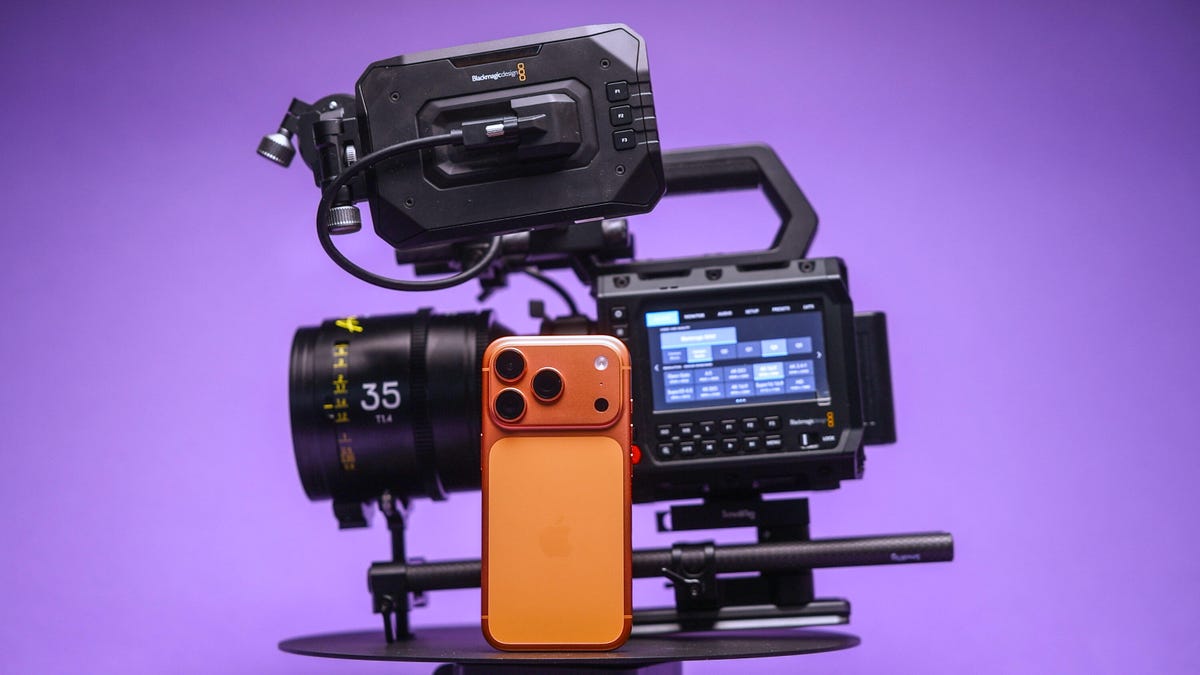
The iPhone 17 Pro packs a powerful video setup with a trio of cameras, large image sensors (for a phone), ProRes raw codecs and Log color profiles for advanced editing. It makes the phone one of the most powerful and dependable video shooters among today’s smartphones.
Apple often boasts about famous directors using the iPhone to shoot films and music videos. The company even records its event videos for new products with the iPhone.
But is the iPhone really good enough at shooting video to replace a traditional cinema camera? To see how good the iPhone 17 Pro is for professional use, I gave it a proper test.
I put together a video shoot where I pitted the $1,000 iPhone against a full professional cinema camera rig, worth thousands of dollars, to see just how well Apple’s phone can hold its own. I planned a video production at my favorite coffee roaster in Edinburgh, called Santu, which is based in a stunning building that I knew would look amazing on camera.
To give both cameras the best chance, I worked with Director of Photography Cal Hallows, who has been responsible for production on major shoots around the world, working with brands including Aston Martin, the BBC, IBM and Hilton Hotels.
Here’s what happened.
Our filming equipment
We didn’t use any external lenses with the iPhone; instead, we relied on either the built-in main, ultrawide or telephoto options. I shot my footage using the BlackMagic Camera app. I had a Crucial X10 external SSD since I was recording in Apple’s ProRes raw codec, which creates large files.
I also had a variable neutral density filter to achieve a consistent shutter speed. For some shots, I used Moment’s SuperCage to help give me a better grip — and therefore smoother footage. But for other shots, I just used the phone by itself to make it easier to get into tight spaces. More on that later.
The iPhone’s competition was the $3,300 BlackMagic Pyxis 6K. It’s a professional cinema camera with a full-frame 6K resolution image sensor and raw video capabilities. I paired that with some stunning pro cine lenses, including a set of Arles Primes, the XTract Probe lens from DZO Film and a couple of choice cine primes from Sigma. It’s a formidable and pricey setup for any cinematographer.
The shoot day
We shot over the course of a single day. I’d already created a rough storyboard of the shots I wanted to get, which helped me plan my angles and lens choices. I wanted to try and replicate some angles directly with both cameras.
This shot of the store room being opened (above), for example — was a lovely scene, and I didn’t see much difference in quality between the iPhone’s video and the BlackMagic’s. This was the case with a few of the scenes we replicated. Apple’s ProRes raw codec on the iPhone provided a lot of scope for adjusting the color, allowing us to create beautiful color grades that looked every bit as striking as footage from the Blackmagic camera.
Sure, you could tell that they were different, but I couldn’t honestly say if one was better than the other.
Other shots were more difficult to replicate. I love this low-angle of the roastery owner, Washington, pulling his trolley through the scene. On the iPhone, the main lens wasn’t wide enough to capture everything we wanted but switching to the ultrawide was too much the other way and we ended up having spare gear and other people in the frame.
This made several shots a challenge to replicate as the fixed zoom ranges of the iPhone simply didn’t translate to the same fields of view offered by our lenses on the BlackMagic camera. As a result, getting the right framing for shots from the iPhone was trickier than I expected. But focal length wasn’t the only reason using «real» lenses was better.
The DZO Arles Primes are awesome cinema lenses that offer wide apertures that allowed us to shoot with gorgeous natural bokeh. We used this to our advantage on several shots where we really wanted the subject to be isolated against an out-of-focus background.
Secret weapons
That was especially the case when we used our secret weapon: the DZO Films Xtract probe lens. This bizarre-looking, long, thin lens gives both a wide-angle perspective coupled with a close focusing distance.
I loved using the probe lens for this shot, particularly where we’ve focused on exactly where Washington was using the bean grinder. I tried to replicate it on the iPhone using the close-focusing ultrawide lens and the shot looks good, but it lacks the visual sophistication that I can get from a big, professional camera. Especially because the lack of background blur makes it easier to see distracting background items stored under the counter that are otherwise «hidden» in the blur on the main camera.
But the iPhone has its own secret weapon, too. Its size. The tiny dimensions of the iPhone — even with a filter and the SSD crudely taped to it — is so small that we were able to get shots that we simply couldn’t have achieved with the big cinema camera.
In particular, this shot, where I rigged the iPhone to an arm inside the cooling machine so that it travelled around as the beans were churned. I love this shot — and a top-down view I shot of the arms turning beneath. Both angles give this incredible energy to the film and I think they are my favourite scenes of the whole production. It wasn’t easy to see the phone screen in these positions but SmallRig’s wireless iPhone monitor made it much easier to get my angles just right. Trying to rig up a large, heavy camera and lens to get the same shots was simply out of the question.
How well did the iPhone compare?
I’m really impressed with both cameras on this project, but my expert Director of Photography, Cal, had some thoughts, too.
«The thing I really found with the iPhone,» Cal explained, «was simply the creative freedom to get shots that I’d have never had time to set up. There’s only so long in a day and only so long you have access to filming locations or actors, so the fact that you can just grab your iPhone and get these shots is amazing.»
«I have used my iPhone on professional shoots before. One time in particular was when I was driving away from set and I saw this great sunset. If I’d have spent time rigging up my regular camera, I’d have missed the sunset. So I shot it on my phone and the client loved it — it ended up being the final shot of the film. At the end of the day, a good shot is a good shot and it doesn’t matter what you shot it with,» said Cal.
So was it all good for the iPhone?
«The depth of field and the overall look of the cinema lenses still come out on top — you’re just not going to get that on a phone,» explained Cal. «When it came to grading the footage, I had to use a lot of little workarounds to get the iPhones to match. The quality quickly started to fall apart in certain challenging scenes that just weren’t a problem with the BlackMagic.»
So it’s not a total win for the iPhone, but then, I never expected it to be. The iPhone was never going to replace the pro camera on this shoot, but it instead allowed us to augment our video with shots that we would otherwise never have gotten.
I love the creative angles we found using just the phone, and while Cal struggled to balance its colors as easily, the footage does fit in nicely with the rest of the video and makes it more dynamic and engaging as a result.
And that’s not to say the shots we didn’t use from it weren’t good. I’m actually impressed with how the iPhone handled most of the things we threw at it.
So don’t assume that if you want to get into filmmaking, you need to drop tens of thousands on a pro cinema camera and a set of cine primes. Your iPhone has everything you need to get started, and it’ll let you flex your creativity much more easily.
Our days of shooting, editing and grading have proven that the iPhone isn’t yet ready to be the only camera you need on a professional set. But mix its small size in with your other cameras, and then you’ve got yourself a truly powerful production setup.
Technologies
I Tried These Turbocharged XR Sunglasses at Disney Studios and Got a Stunning New View
I checked out Disney-backed startup Liminal Space’s tech in person. Its glasses are a theme park experience waiting to happen.

Standing on a crate inside Walt Disney Studios Stage 1 is Rocket from Guardians of the Galaxy. He’s talking with a crowd of people wearing the same ordinary-looking sunglasses that I am, and is larger than life, speaking with full-body movements and natural gestures.
Then I take off the glasses, and I can see that Rocket was on a screen, not an animatronic figure standing on the physical crate. When Rocket stops moving, out from behind a curtain — Wizard of Oz-style — steps an actor who’s been doing all the movements and voice work on Rocket’s behalf.
I could wear these glasses all day and never know there’s anything out of the ordinary about them. They’re regular sunglasses when you’re outdoors, before transforming into XR glasses when you look at a special screen.
Don’t miss any of our unbiased tech content and lab-based reviews. Add CNET as a preferred Google source.
The LED screen technology and glasses come from Liminal Space, a startup selected as part of the 2025 Disney Accelerator Program. Starting out by providing AR experiences at music concerts, Liminal Space creates display systems with microLED chip technology. This produces holographic 3D displays used for everything from stadiums and arenas to smaller spaces like attractions and galleries.
During a Demo Day event at Walt Disney Studios in Burbank in November, Liminal Space co-founder and CEO Nathan Huber explains on-screen that he wanted to improve on how virtual reality is a «solo, isolating experience» because you’re wearing a hulking headset alone, and all you can see is the display. You can’t share it with the people around you.
«We can give you that same level of immersion and awe [as VR], but you can now see your friends and family … and do it all for one to 10,000 people at the same time,» Huber says in the Demo Day video, describing a world where things are «augmented by digital enhancements all around you.»
Liminal Space’s sunglasses are a little closer to augmented reality (AR) than they are to VR, as well as a huge step up from old-school 3D glasses that are currently used in theme parks.
Whereas VR — like Apple’s Vision Pro and Meta’s Quest 3 — requires a headset and drops you into a fully virtual world, AR overlays the real world with graphics. Smart glasses, like Meta’s Ray-Bans (which Disneyland has already been experimenting with), use AR to overlay information over the real world, as well as providing camera-recording functions and phone connectivity.
As theme parks compete with one another to provide their guests with the most immersive atmosphere possible, Disney’s backing of Liminal Space shows it’s interested in adding more hyperrealistic screens to its parks.
How realistic are these XR visuals?
After Rocket steps away, the Liminal Space demo screen takes us through the world of Avatar, showcasing landscapes from the upcoming sequels (no photos allowed). We soar through thick green vegetation, pulsating trees, floating cliffs, neon flowers and flying reptiles.
«The quality of the visuals — it is bright, it is crisp, I am seeing details in this footage that I’ve never seen before,» Leslie Evans, executive Imagineer at Walt Disney Imagineering R&D, says in the video. «People painstakingly rendered these scenes, and if that’s happened, I want you to see every detail. I want the contrast to be top-notch, I want you to feel like it’s real.»
It does feel as real as 3D and VR can: Everyone gasps as we reach a summit in the Avatar world and tilt forward, «falling» down into the rainforest below. Despite these dizzying heights, it’s somehow less nauseating than strapping on a full VR headset and gazing into another reality. Maybe it’s because you can still see the real world around you, or because you’re not wearing a heavy headpiece.
Leaving aside the comparisons to VR and AR, these glasses offer a far more sophisticated version of the screens on the Avatar Flight of Passage ride at Disney’s Animal Kingdom in Florida, especially with those new Avatar visuals I experienced. Liminal Space’s sunglasses are the next step up from those awkward, plasticky sets handed to you at the start of rides and shows like PhilharMagic and Toy Story Mania — the ones you’re told not to wear until the show starts, and that only really work if you’re looking dead straight at the screen and position them just right — with the idea being that you could walk around comfortably in them all day and have them work everywhere.
This seems to be what Disney intends to do with the technology (Disney tells me it’s still exploring possibilities and doesn’t have anything to share just now). The glasses do double duty, both as sunglasses and whenever you come into contact with a screen at an attraction or while strolling through a land.
Modular screens throughout theme parks?
The Liminal Space glasses also work from multiple viewing angles while looking at screens, which helps create the feeling of total immersion.
Michael Koperwas, supervisor of Creative Development and Digital Design at Industrial Light & Magic — the famed visual effects studio founded by Star Wars creator George Lucas in the 1970s — spoke about using modular screens from Liminal Space for park experiences.
«All of these different screens create these low-friction, wonderful ways to expand the world that you’re already in,» Koperwas says during the Disney Demo Day showcase video. «Having a modular display like that is essential to creating these locations that feel seamless, feel magical, feel wonderful, and are just full of surprises.»
The company’s glasses are cheap to make, Liminal Space says, meaning theme parks could easily provide thousands of pairs to guests, who could even leave with them at the end of the day and bring them back for their next visit.
It wouldn’t be Disney’s first park wearable: In 2013, Disney introduced the MagicBand for guests to buy and wear at Walt Disney World, allowing them to swipe the band to enter parks and their hotel rooms, and to pay for merchandise and food. The MagicBand Plus added more functionality and came to Disneyland in 2022.
At Liminal Space’s demo, I switch from black-framed sunglasses to white ones and walk into the next room. It has an enormous circular screen showing Impressionist artworks, fading out of one and into the next. A gargantuan Vincent Van Gogh stares at me, inviting me to step inside his Self-Portrait with a Straw Hat. The image shifts to Van Gogh’s Sunflowers, and the soft saffron petals curl out toward me.
The image changes again, and this time I’m not just looking at a centuries-old painting — I’m standing in a European street as snow falls around me. Like a child watching a 3D movie for the first time, I can’t help but reach out to try to touch the drifting snowflakes. Through the Liminal Space sunglasses, they’re moving all around me.
And unlike those traditional 3D glasses you’d wear to watch a show in Disneyland, where the image doesn’t appear to be any closer if you move closer to the screen, Liminal Space’s demo feels like you’re stepping into the video itself. As I walk slowly closer to the falling snow, it begins to fall around me, moving into my peripheral vision as well as in front of me.
Walt Disney Imagineering wants to give park guests immersive experiences like these that don’t just feel like looking at a TV, says Jody Gerstner, executive of Show Systems at Walt Disney Imagineering.
«Because the circular [screen] performs so well with this bright an image, and because the filter gives you an unfettered view when you move your eyes back and forth, it could be a big win in our guest quality,» Gerstner says in the Demo Day video.
Speaking to a packed theater, Bonnie Rosen, general manager of Disney Accelerator, says the whole point, whether it’s AI, 3D printing or VR, is creating imagination that comes to life.
«Innovation happens every day at Disney,» she says. «This company lives and breathes creativity. We just don’t talk about it until it looks inevitable, and then someone calls it ‘Disney magic.'»
Technologies
Verum Messenger: A Privacy-Driven Ecosystem With AI, Crypto Mining, and Global Connectivity
Verum Messenger: A Privacy-Driven Ecosystem With AI, Crypto Mining, and Global Connectivity
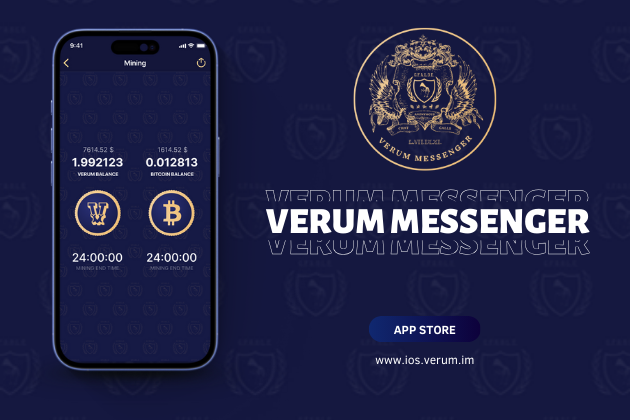
As digital privacy becomes both a global concern and a personal necessity, Verum Messenger for iOS positions itself as more than another encrypted chat app. It offers a full ecosystem built around anonymity, user control, and technological independence — including AI tools, anonymous email, built-in eSIM, secure VPN access, and even cryptocurrency mining directly inside the messenger.
In an era of surveillance, data leaks, and intrusive applications, Verum represents a shift toward user-owned digital identity.
A Messenger Designed for Complete Anonymity
Unlike platforms that require phone numbers, email addresses, or personal details to sign up, Verum Messenger removes the concept of identity tracking altogether. Registration requires no personal information.
Users receive a unique Verum ID and a Recovery Key, both stored solely on the user’s side. All encryption keys are generated locally on the device and never transmitted to servers — eliminating the risks associated with centralized storage.
Communication Built on Trust and Security
Verum’s communication tools cover all standard messenger functions but enhance them with multilayered protections that exceed current industry norms.
Key security features include:
- End-to-end encrypted chats and calls
- Protection against screenshots and screen recording
- Alerts when someone saves or downloads media
- One-tap full data wipe
- Disabled message forwarding, copying, and exporting
- Temporary messages with customizable timers
- Support for large private communities (up to 10,000 participants)
A particularly distinctive feature is mandatory chat confirmation:
— No one can message, call, or add you without your explicit approval.
— This effectively blocks spam, fraud, unsolicited outreach, and unwanted communication at the source.
Built-In Tools Without Compromising Privacy
Verum integrates an intelligent chatbot — similar to GPT — directly into the messenger. Unlike typical AI tools, which rely on cloud processing tied to user identities, Verum adheres to its core privacy principle: no personal data is shared with external systems.
The built-in anonymous email service enables users to send and receive messages securely. Emails can auto-delete after a chosen period, minimizing digital traces.
A built-in eSIM marketplace provides mobile internet in 150+ countries — essential for travelers, freelancers, journalists, and remote workers.
No physical SIM cards. No roaming. No long-term contracts.
A native VPN ensures encrypted and private internet connections, adding an additional layer of protection beyond messaging alone.
Crypto Mining Inside the Messenger
One of Verum Messenger’s newest and most innovative features is something no mainstream secure messenger offers: built-in cryptocurrency mining.
Users can mine:
- Verum Coin, the platform’s native asset
- Bitcoin, recently added to the ecosystem
Mining operates directly within the application — with no specialized hardware or external services required.
Why Verum Stands Out
Today’s digital environment forces people to juggle countless separate apps — one for a VPN, another for mobile data, a different one for AI tools, crypto management, and secure messaging. Verum Messenger brings all of these capabilities together in one platform, without ever compromising privacy or user autonomy.
Verum Messenger combines them all into a single platform without sacrificing privacy or user autonomy.
Instead of functioning as a social network, it becomes a private digital workspace — secure, anonymous, and self-contained.
Verum Messenger is available on the App Store.
Account activation is a one-time process; no subscription is required.
Official website: https://verum.im
iOS app: https://ios.verum.im
Documentation: https://docs.verum.im
-

 Technologies3 года ago
Technologies3 года agoTech Companies Need to Be Held Accountable for Security, Experts Say
-

 Technologies3 года ago
Technologies3 года agoBest Handheld Game Console in 2023
-

 Technologies3 года ago
Technologies3 года agoTighten Up Your VR Game With the Best Head Straps for Quest 2
-

 Technologies4 года ago
Technologies4 года agoBlack Friday 2021: The best deals on TVs, headphones, kitchenware, and more
-

 Technologies4 года ago
Technologies4 года agoVerum, Wickr and Threema: next generation secured messengers
-

 Technologies4 года ago
Technologies4 года agoGoogle to require vaccinations as Silicon Valley rethinks return-to-office policies
-

 Technologies4 года ago
Technologies4 года agoOlivia Harlan Dekker for Verum Messenger
-

 Technologies4 года ago
Technologies4 года agoiPhone 13 event: How to watch Apple’s big announcement tomorrow
